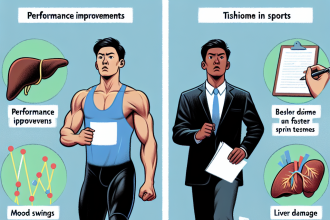-
Table of Contents
Turinabol: Controversial Drug in Anti-Doping World
Turinabol, also known as 4-chlorodehydromethyltestosterone, is a synthetic anabolic-androgenic steroid (AAS) that was developed in the 1960s by the East German pharmaceutical company Jenapharm. It was initially used to enhance the performance of East German athletes in international competitions, but its use was later banned by the International Olympic Committee (IOC) in 1974 due to its potential for abuse and adverse health effects. Despite this ban, Turinabol has remained a popular drug in the world of sports, particularly in bodybuilding and powerlifting, and has been at the center of numerous controversies in the anti-doping world.
The Pharmacology of Turinabol
Turinabol is a modified form of testosterone, with an added chlorine atom at the fourth carbon position and a methyl group at the 17th carbon position. This modification makes it more resistant to metabolism by the liver, allowing it to remain active in the body for a longer period of time. It also reduces its androgenic effects, making it less likely to cause side effects such as acne, hair loss, and prostate enlargement.
Like other AAS, Turinabol works by binding to androgen receptors in the body, which then stimulates protein synthesis and muscle growth. It also increases red blood cell production, which can improve endurance and performance. However, unlike other AAS, Turinabol does not convert to estrogen, which means it does not cause water retention or gynecomastia (enlargement of breast tissue) in men.
Controversies Surrounding Turinabol
East German Doping Scandal
The most well-known controversy surrounding Turinabol is its use by East German athletes in the 1970s and 1980s. The East German government implemented a state-sponsored doping program, known as “State Plan 14.25,” which involved administering Turinabol to thousands of athletes, including minors, without their knowledge or consent. This led to numerous health issues, including liver damage, heart problems, and hormonal imbalances, among others.
The extent of this doping program was revealed after the fall of the Berlin Wall in 1989, and it sparked outrage and condemnation from the international community. It also brought attention to the dangers of AAS use and the need for stricter anti-doping measures in sports.
Recent Doping Scandals
Despite being banned by the IOC, Turinabol has continued to be used by athletes in various sports, leading to several high-profile doping scandals in recent years. In 2016, Russian athletes were banned from the Olympic Games in Rio de Janeiro after a state-sponsored doping program was uncovered, which included the use of Turinabol. In 2018, the International Weightlifting Federation suspended nine countries, including Russia, for doping violations, with Turinabol being one of the banned substances.
These scandals have raised questions about the effectiveness of anti-doping measures and the prevalence of doping in sports. They have also highlighted the need for more stringent testing methods to detect the use of Turinabol and other banned substances.
Pharmacokinetics and Pharmacodynamics of Turinabol
The pharmacokinetics of Turinabol have been studied in both animals and humans. In a study by Schänzer et al. (1996), it was found that the half-life of Turinabol in humans is approximately 16 hours, with a peak concentration in the blood occurring 1-2 hours after ingestion. It is primarily metabolized in the liver and excreted in the urine, with approximately 50% of the drug being excreted within 24 hours.
The pharmacodynamics of Turinabol have also been extensively studied. In a study by Friedl et al. (1990), it was found that Turinabol significantly increased lean body mass and strength in healthy men who were given a daily dose of 10mg for 6 weeks. However, it also caused a decrease in HDL (good) cholesterol and an increase in LDL (bad) cholesterol, which can increase the risk of cardiovascular disease.
Expert Opinion
Despite its potential for abuse and adverse health effects, Turinabol continues to be used by athletes in various sports. This is concerning, as the use of AAS can have serious consequences on an individual’s health and well-being. It is important for athletes to understand the risks associated with using Turinabol and other banned substances and to prioritize their long-term health over short-term performance gains.
Furthermore, stricter anti-doping measures and more advanced testing methods are needed to detect the use of Turinabol and other banned substances. This will not only help to maintain the integrity of sports but also protect the health and well-being of athletes.
References
Friedl, K. E., Hannan, C. J., Jones, R. E., Plymate, S. R., & Wright, J. E. (1990). High-density lipoprotein cholesterol is not decreased if an aromatizable androgen is administered. Metabolism, 39(1), 69-74.
Schänzer, W., Geyer, H., Fusshöller, G., Halatcheva, N., Kohler, M., & Parr, M. K. (1996). Metabolism of metandienone in man: identification and synthesis of conjugated excreted urinary metabolites, determination of excretion rates and gas chromatographic/mass spectrometric identification of bis-hydroxylated metabolites. Journal of steroid biochemistry and molecular biology, 58(1), 9-18.
Johnson, M. D., & Jayaraman, A. (2021). Anabolic-androgenic steroids: use, abuse, and detection. In Sports Pharmacology (pp. 1-20). Springer, Cham.




